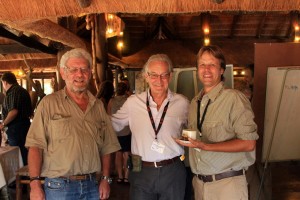International Elephant Conservation and Research Symposium
Elephants Without Borders, Mike and I, recently attended the International Elephant Conservation and Research Symposium, held by the International Elephant Foundation and hosted by the National Zoological Gardens of South Africa, held on the Kwalata Game Ranch on Jan. 25-29. The program was attended by nearly 90 delegates representing 19 countries from around the world, a diversified range of elephant related vocations from non-profit organizations, zoological organizations, universities and independent entities.

Prof. Rudi Van Aarde, Dr. Iain Douglas-Hamilton, Dr. Mike Chase having discussion over a cup of tea
These are some of the highlights of the conference:
The first day topics pertained to disease common to elephants both in captivity and in the wild. A strong emphasis was placed on Elephant Endotheliotropic Herpesviruses (EEHVs), a family of herpesvirus that bring an onset of hemorrhagic disease causing sudden death. Interestingly, there are several strains of these herpesviruses, which are found in both Asian and African elephants, but each species does not share all of the various strains. It is most commonly found in young elephants in captivity, but studies have shown herpesvirus-like particles latently harbored in high numbers of healthy elephants in the wild. It is believed that the survival rate of elephants with this naturally occurring disease depends on their development of protective anti-bodies. We will learn more about these diseases, as more research is conducted. Leading the studies are researchers from John Hopkins University, the Smithsonian National Zoological Park and the National Zoo in Washington D.C.
Afternoon, the delegates were transferred to the National Zoological Gardens in Pretoria for a tour and dinner. It was a perfect way for everyone to relax and mingle, despite the heavy rains received. A lovely buffet was held at the zoo’s restaurant, the Water Hole, which overlooks a large enclosure occupied by gemsbok and impala, grazing around a large watering hole. Gary Albyn recited his enchanting poem, “Manzovo, Place of the Elephants”, for the evening’s entertainment.
Day two, the morning presentations addressed reproduction studies on both male and female elephants. The topics included: semen analysis; feasibility of sex-sorting sperm; sperm motility (quality); immunocontrol of aggressive behavior in bulls; physiology of elephant ovaries; and immunocontraception. These studies pertain to relevant strategies designed to control growth of elephant populations in smaller, fenced parks and to support fertility and reproduction of captive elephants.
I personally was looking forward to the afternoon’s topic, which was on new technologies in elephant conservation. A strong emphasis was placed on understanding and mitigating human-elephant conflict (HEC.) Leading the subject was a group of researchers and conservationists from Sri Lanka, who presented an automated elephant recognition system, predictive modeling of regional susceptibility of elephants, an electric fence intrusion alert system, and a Google mechanism for networking called “elephant portal.” In the evening, we grouped onto buses and were given a tour of the local township, watched a demonstration by a traditional healer, tried the local brew called “Shake Shake” and had dinner and dancing at a local Shebeen.

Ravi Corea, President of Sri Lanka Wildlife Conservation Society
The third day’s sessions’ concentrated on the subject termed “Living with Elephants,” focusing on elephant conservation, community conservancies, ecological utilization, management monitoring, HEC, outreach and educational programs. The opening presentation was given by well-respected Dr. Iain Douglas-Hamilton, addressing landscape assessment of risk to elephants by the Monitoring the Illegal Killing of Elephants (MIKE) program, demonstrating that increasingly elephants are now concentrating in low risk areas, however unfortunately it also shows that for the last 7 years, illegal killing for ivory has been escalating. Successful conservation programs working with local communities and conservancies were presented by Juliet King in Kenya, Michael Keigwin in Uganda, Harold Schwammer, Ravi Corea and Chandeep Corea in Sri Lanka and Alexandra Zimmerman in India. An interesting and unique presentation was given by a civil engineer, Ajay Pal Singh, who has been given the task to create an elephant corridor across a road and rail line in the Himalayan foothills of India. Veterinary care topics were covered in the latter half of the afternoon including evaluations of body conditions, successful treatment of burns, and musth management.
On the last day, management of elephants in human care was presented. Mohamed Muynudeen talked on the symbiosis between wild and captive elephants, “then and now”, and showed a clip from the 1940’s of how captive elephants were trained and used to capture wild elephants. The video brought tears to many of the viewers’ eyes, myself included. An interesting topic was presented by Sean Hensman, on how they have been working with their elephants to train them to detect various things by elephants’ acute sense of smell, including to track thieves and poachers, and detect cancer and landmines. Harold Schwammer presented The Global Elephant Management Program whose primary goal is to improve management, welfare, and protect existing populations of elephants in human care. Deborah Olson gave the last presentation, discussing the International Elephant Foundation’s role in elephant conservation.
The symposium came to a close, but I am glad that we took the opportunity to participate and especially for all the new colleagues I had the chance to meet. The information and expertise shared and the initiatives and partnerships that may develop from it stand to only better the circumstances in which we share with elephants. To learn more about Elephants Without Borders activities, log on to www.elephantswithoutborders.org
Panel of experts from around the world, discussing elephant conservation
Tags: africa, botswana, conference, conservation, elephants, research, South Africa








Sorry we missed it.
Would have liked it if you could have joined us, Doug! Next time… hope to see you soon. EWB